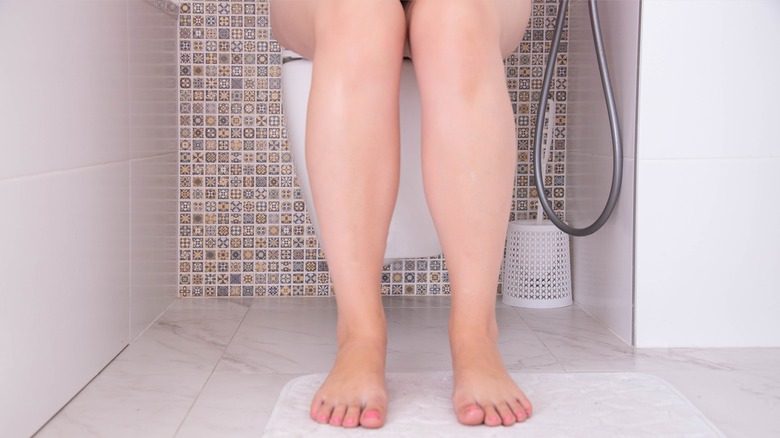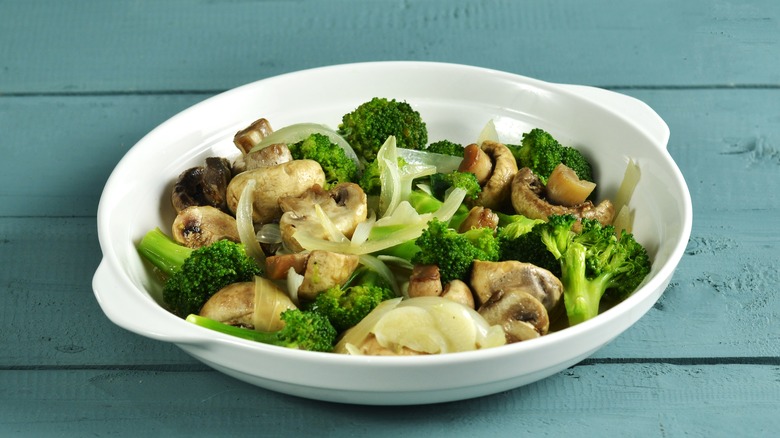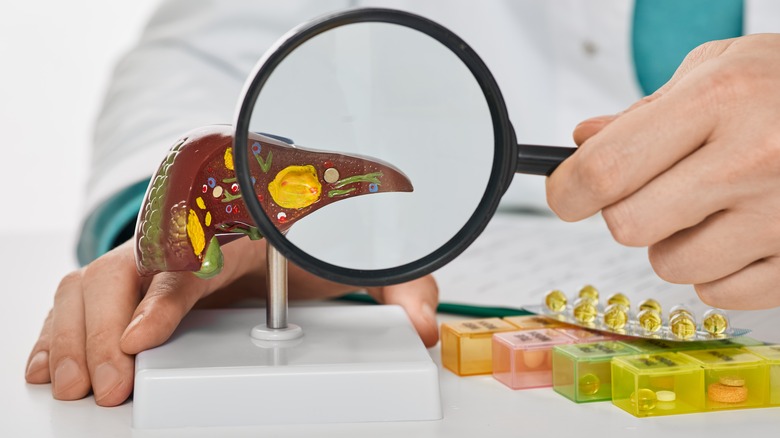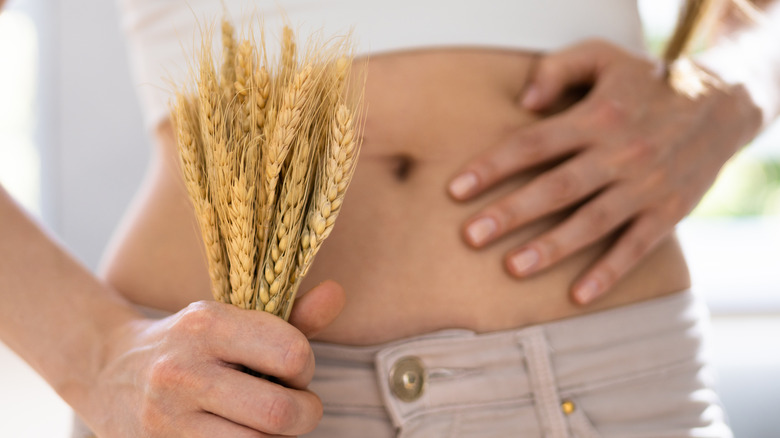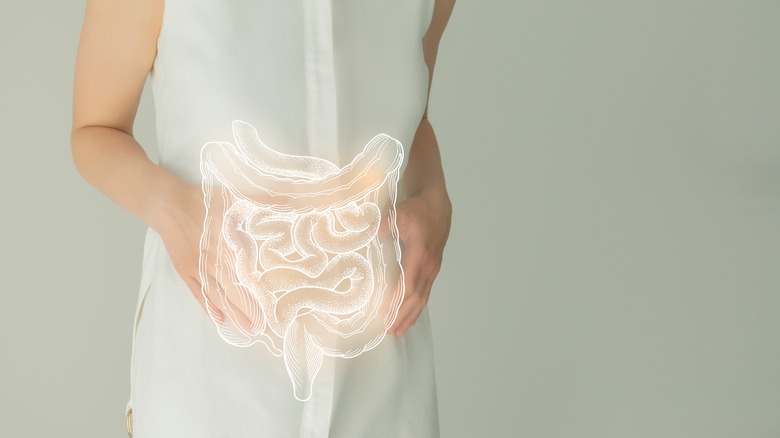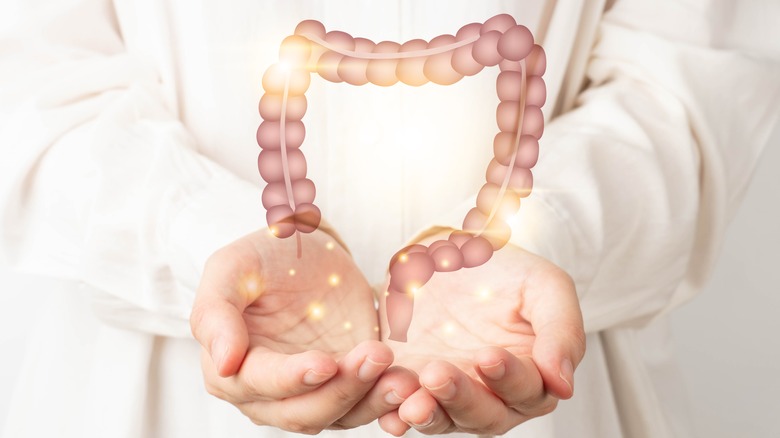What The Color Of Your Stool Means
Although it sounds a little distasteful, it's worth taking a closer look at your poop from time to time. You've probably noticed that stool comes in different shapes and colors. This change in appearance is usually a good indicator of your diet (via WebMD). Therefore, the current color of your stool will largely depend on what you've eaten recently. Whether you ate chocolate or salad, the waste products your body excretes inevitably turn into brown poop — but why is stool sometimes green, black, or gray?
According to the University of California San Diego, roughly 75% of stool is water. Bacteria, undigested food, mucus, and bile make up the other 25%. Although the color of your poop is influenced by what you eat, a yellowish-green bile pigment that travels through the gastrointestinal tract is what alters the color of your stool from green to brown.
According to the Mayo Clinic, color changes in your poop are natural. However, there are instances where a particular stool color might indicate a worsening medical condition or a medication's side effect. In such situations, it's only fair to know what's happening, so you don't overthink or leave your health to chance. Listed below are the most common stool colors and their health implications.
Green stool
According to the Cleveland Clinic, your stool might be green if you eat lots of vegetables like broccoli and spinach. The green color mostly comes from the chlorophyll element in these vegetables. Besides vegetables and herbs, eating hemp seeds, pistachios, and green fruits like avocados can also cause green stool. Your stool might also be green if you eat processed foods containing green food dye, such as cakes with bright green frostings. Besides food, certain medications like antibiotics may alter your natural gut flora, adding a greenish tint to your feces.
Beyond what you eat, your stool can also turn green when you're sick. Normally, the yellowish-green bile pigments in the gastrointestinal tract work with enzymes and bilirubin to change stool color to the normal brown color. Some health conditions like diarrhea may cause food to pass through the large intestines too quickly, leaving little time for the bile to do its job (via the University of California San Diego).
Some health conditions affecting the digestive system can also cause fecal discoloration. Typical examples include Crohn's disease, characterized by an inflammation of small and large intestinal layers (via Medical News Today). Other health conditions that cause you to pass green stools include piles, cancer of digestive organs or gastrointestinal tract, and ulcerative colitis.
White stool
As previously mentioned, bile, produced by the liver, gives feces its usual normal brownish color. Therefore, pale, whitish stool might be a cause for concern. According to the Mayo Clinic, white or claylike stool might indicate an underlying health condition or a blockage (by a gallstone or tumor) of the duct that delivers the bile to the small intestine. This often comes with adverse digestive health symptoms, including abdominal pain, fever, and nausea.
Any problem with the liver can cause white stool since it plays an active role in bile production. Several other conditions that prevent bile from doing its job include liver diseases such as cirrhosis and hepatitis, per the Mayo Clinic. In addition, abusing medications like acetaminophen and ibuprofen can harm the liver, resulting in white stools, according to Medical News Today.
If your stool is pale, it's vital to visit your doctor for a proper diagnosis and the available treatment options.
Yellow stool
Yellow, greasy, and foul-smelling stool has several causes that include your diet and stress levels, according to Healthline. When you're feeling stressed or anxious, your body might speed up your digestion, which limits the number of nutrients being absorbed. Such situations often cause diarrhea and yellow stool, per Healthline. Your stool might also become yellow after eating certain gluten products or yellow-pigmented foods, like carrots or sweet potatoes, per Healthline.
According to Medical News Today, yellow stool is also linked with celiac disease, which is an autoimmune condition. When people with celiac disease eat gluten, their body responds by attacking the tissues of their small intestine, which compromises their ability to absorb nutrients (via Medical News Today).
People battling liver disorders like cirrhosis or hepatitis can experience yellow stools because their livers are not producing enough bile salts.
Pancreatic disorders can also cause yellow stools. In such cases, yellow stool is due to the pancreas' inability to produce the enzymes needed to digest food.
There might be no cause for concern if you have a one-off case of yellow stool and no medical history of the above-mentioned conditions. However, it's crucial to consult with your doctor if your poop's color doesn't revert back to normal after a few days.
Black stool
According to WebMD, stool can be dark in people who eat dark-colored foods like blueberries or beets. Also, if you have anemia and your stool is black, it might be a side effect of the iron supplements you're taking, per WebMD. Some medications that contain bismuth subsalicylate can cause black stool, according to Healthline.
In addition to food and medications, ulcers can also cause black stool. According to Healthline, ulcers are open sores in the digestive tract's lining. Symptoms of ulcers include a burning sensation in the stomach, heartburn, and indigestion. When an ulcer bleeds, it mixes with digestive fluids, causing black, sticky, and tarry stool. A similar mechanism of action may apply if you have upper gastrointestinal bleeding. These conditions may not heal independently and can become critical the longer you stay without treatment. Therefore, it's crucial to seek early diagnosis.
A physical examination might be needed to ascertain the cause. Your doctor might ask questions about your diet, lifestyle, and the duration of symptoms accompanied by your black stool, according to MedlinePlus. Further tests using a colonoscopy, or angioscopy, might be required to help confirm any suspicions. Treatment options depend on the results — some can be extensive, requiring hospitalization or surgery, per Medline Plus.
Red stool
Seeing blood in your stools can be frightening. The blood-soaked tissue or bright red stools can also be enough evidence. However, sometimes you may not see it until you take a fecal occult test. According to WebMD, bright red blood in your stool might signal an issue with your digestive tract or might be linked to severe conditions like tears in the esophagus (which can cause severe blood loss) or colorectal cancer (which is often characterized by noticeable bleeding), per WebMD.
You might also see blood in your stools if you have hemorrhoids, as explained by the Cleveland Clinic. This condition is common in people who are pregnant, overweight, or who usually engage in anal sex, per the clinic. Also, large polyps, ulcers, and diverticulitis may cause rectal bleeding, resulting in bright red blood in your stool.
According to Johns Hopkins Medicine, it's important to locate the source of the bleeding, hence the need to visit your doctor. Usually, doctors use endoscopy to identify the bleeding site. Other diagnostic techniques include CT scans or barium X-rays, per the source. Treatment options are diverse and include chemical injections directly into the bleeding site. Medications are also prescribed to prevent recurrent bleeding episodes, especially if caused by an ulcer. The last resort is often surgery which is recommended when all the treatments mentioned above fail to control bleeding.

